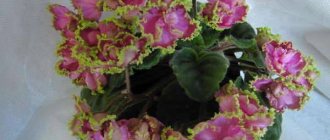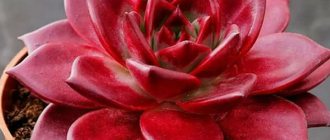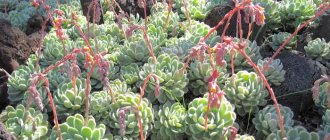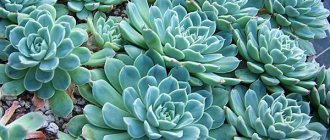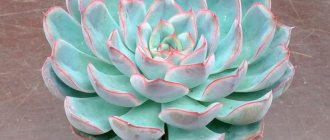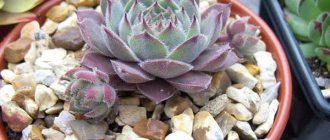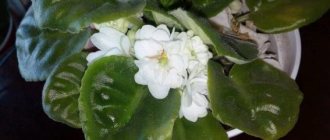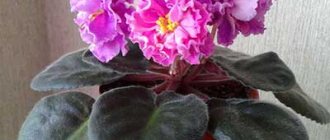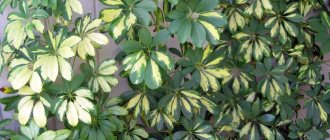International name:
Synonyms:
Characteristics:
| Complexity: |
| Development cycle: |
| Light mode: |
| Watering mode: |
| Temperature: |
| The soil: |
| Key Feature: |
Foliage color
Bud color
Dimensions Flower sizes
Taxonomy:
| Domain: |
| Kingdom: |
| Department: |
| Class: |
| Order: |
| Family: |
| Genus: |
There are quite a few attractive species of Echeveria. But if you are looking for elegance, Echeveria Perle von Nurnberg is worth a look.
The spoon-shaped leaves of this succulent overlap each other to create a perfect rosette. However, the highlight of the Pearl is its color. The plant's coloration is a spectrum of blue-gray and pink with a hint of purple.
Although Echeverias are native to Mexico, this hybrid is native to Germany. This is truly the perfect succulent for beginning gardeners. It is easy to care for and propagate.
Description of plants of the genus Echeveria
Succulents of the genus Echeveria were given their name by the French botanist Augustin Piram de Candolle in 1828. The venerable botanist was on an expedition to Central America in the company of the Mexican botanical artist Atanasio Echeverría and Godoy. The Frenchman was so impressed by Athanasio's artistic skill that he named one of the documented plant families after the artist. Thus, one of the most famous and widespread genera of succulents was named Echeveria.
Echeverias are considered one of the most beautiful succulents. They form attractive rosettes of succulent leaves and often resemble roses, water lilies or tousled lettuce. These are fairly small houseplants, but still very robust and easy to care for. You can forget to water them for a month without them wilting. Plants prefer desert conditions.
Photo of Echeveria in the botanical garden
The leaves come in a variety of colors from simpler greens to some really showy colors. As a rule, the leaves form a rosette that remains almost unchanged throughout life. Forming a rosette allows for maximum exposure to light sources, allowing plants to effectively capture and direct water down to the roots.
The Echeveria succulent plant grows well in both containers and garden beds. The variety and color of Echeveria plants provide wonderful tone and texture for mixed flower beds and containers. The leaves are fleshy and have a waxy cuticle on the outside; touching them can damage the skin of the leaf and leave marks. Often the leaves are colored. Echeveria grows slowly and usually does not exceed 30 cm in height or width.
Echeveria blossom
"Stone Rose" blooms in spring or summer. A long vertical or lateral peduncle becomes the point where lateral-type inflorescences consisting of small flowers appear. The shade of the buds is different. May be brown, red, orange-red or yellow. The petals are quite juicy. Based on how bright the lighting is, the color saturation of the flowers itself also changes. Those that form in the shade have yellowish hues, while those that form under ultraviolet rays have reddish colors.
Interesting facts about the name
In some sources you can see the name Echeveria. By and large, both names are correct.
The name Echeveria in Spanish sounds like Echeveria, since the culture received its name in honor of the name of the Mexican artist Anastasio Echeverria, who drew illustrations for books describing the flora of Mexico.
Echeveria Agavoides "Red Edge"
If we turn to Latin, which is usually used in botany, the name will sound like Echeveria.
However, recently, even at international conferences, the question of changing the Latin names to those that were originally given by the discoverers of plants has been raised.
The mystery of the blue orchid
People even call the plant “stone rose” or “stone flower.”
This plant is widely used to create home vertical gardens or flower arrangements with succulents and cacti.
Echeveria succulent: how to care at home
“Stone Rose” perfectly withstands both increases and decreases in air temperature; it is also not afraid of ultraviolet radiation or the dry microclimate in the room. That is why the best option for planting would be a window facing south.
During the warm season, these succulent crops feel great both at home and outdoors. In winter, you will need to find a suitable place with a temperature of no more than +10 degrees. If you cannot find suitable conditions for wintering, try to find at least a window sill with the required amount of daylight. If this is not done, the stems will begin to become bare, and the plant itself will become very elongated. The level of air humidity does not matter for a representative of this plant genus. Therefore, there is no need for additional spraying, as well as for thermal showers.
Soil for Echeveria
"Stone Flower" thrives in well-drained soil. Sandy, slightly acidic soil is ideal for succulents. Echeverias don't need as much space for their roots and can cope in small pots and even small paving cracks.
Watering Echeveria
The plant can be watered only after the earthen clod in the container has completely dried. It is best to use filtered water for such purposes. With frequent irrigation, the bush may suffer from root rot. You should also pay attention to stagnant water. It absolutely should not exist, so provide for drainage. If a flower needs watering, you will see it in the foliage - it becomes wrinkled and extremely soft.
How to fertilize a “stone rose”
Fertilizing is allowed only during the growth period. Systematicity – once a month. It is best to give preference to fertilizers suitable for succulent and cactus crops. Starting from September, the application of any fertilizers is stopped.
Transplanting Echeveria at home
Succulent transplantation is carried out in the spring; this is done every year. But this only applies to young flowers. Adult plants are replanted every 3 years. When moving crops, choose small pots with drainage holes. They may be low, but wide enough. A drainage layer consisting of pebbles and expanded clay is laid at the bottom. Afterwards, the flower is transferred from one container to another, adding earth to the voids in the container. The soil is formed from a mixture of peat, expanded clay, loamy soil and charcoal.
Information on caring for succulents
How to prepare optimal soil for succulents: the best soil mixtures
What, how and when to fertilize succulents - expert advice
How to water succulents: what gardeners advise
Echeveria diseases and methods of combating them
If you water too often, water stagnates in the pot. This becomes the main reason for the formation of fungi. To prevent this, water the crop properly, and do this only after the soil has completely dried.
Also, in the process of growing this crop, the following problems may arise:
- Fragility, blackening of shoots is a signal of frequent watering or poor water drainage . To avoid such problems, you should follow the correct watering regime.
- A loose and very elongated rosette indicates a lack of ultraviolet rays . Move the plant to the right place to make up for this deficiency.
- Reducing leaf size . This becomes a clear sign of nutritional deficiency.
If the leaves of the “stone rose” wrinkle, it means it’s time to water.
Succulent pests
This genus is not afraid of most pests; it is quite resistant to various insects. But powdery mildew can cause problems if plants are grown indoors. These pests appear as small white spots on the leaves. If you notice powdery mildew, isolate the plant from other houseplants. Wipe the foliage to remove the pest and, in extreme cases, discard the plant or use an insecticide.
Folk signs and superstitions
Since echeveria has a great external resemblance to young cabbage (rabbit cabbage), folk superstitions often do not distinguish between these two plants. There is a strong belief that the “stone rose” is more suitable for planting in a cemetery and therefore has a negative aura for a living space. However, it is obvious that in this case we are not talking about echeveria, since this crop is too heat-loving to survive in the open ground conditions of churchyards in mid-latitudes.
Other signs:
- Echeveria has long been considered a talisman for the home against dark forces and heavenly fire (lightning strike).
- If a pot of this succulent is placed opposite the entrance to the house, no one will be able to enter it with unclean intentions or filled with envy.
- Grown in the workplace, the echeveria flower will promote career growth and the promotion of risky projects.
- According to esotericists, the plant has neutral energy and easily accepts the energy pole of the person who grows it. If it falls into the hands of an evil and dishonest person, it can subsequently negatively impact others. And vice versa.
How to propagate Echeveria succulent at home
To propagate representatives of this genus, you can use the cutting or seed method. The simplest option is to use seeds.
Propagation of Echeveria by seeds
A small container with peat and sand is being prepared where the seed will be sown. The seeds are evenly laid out on the surface, covered with film or glass on top, and slightly pressed into the ground. Then the containers are moistened with water and placed in a warm room where the temperature will be +20...25 degrees.
When choosing a container, choose small containers with drainage holes. This is important so that excess moisture drains into the pan. It is recommended to observe the first seedlings after 2-3 weeks. Picking is carried out in individual pots. This is done after the appearance of 3 true leaves. Crops that are just being transplanted require a lot of light, so give preference to exclusively illuminated window sills.
Propagation of “stone rose” by leaves and side shoots
Echeveria is also propagated by leaves and stem cuttings. Leaf cuttings take root worse than stem cuttings. Separate the leaf plate from the side of the parent bush so as not to damage it. Air dry. Then the cutting is placed in the prepared substrate and left for a month to root. It will take at least 3-4 months for full growth.
Stem cuttings growing at the tops are harvested in the second half of March. To do this, the cutting is cut off from an adult bush, and then planted in prepared soil. It is better to add sand and compost soil to the pot. The segments are slightly pressed into the ground.
This video shows the process of propagation of Echeveria by leaves and side shoots
The planted cuttings are placed in a warm place with excellent lighting. Then they must be watered. Rooting will take up to 1.5 weeks. After which the crops are planted in permanent containers.
Methods for propagating a flower, when is it best to do it
You can propagate a flower in several ways. The preferred options for propagating echeveria include increasing the number of leaves or rosettes.
Echeveria leaf propagation
Select the healthiest foliage and separate it from the stem. After drying for a week, the outer side is laid out on a pre-moistened substrate and kept until roots appear at +25 ℃. When the first rosettes are formed, they are placed in separate containers.
Important! Specimens that respond well to leaf propagation include Echeveria Pearl of Nuremberg. It takes root well with rare substrate moisture and maximum illumination.
Leaf propagation
Reproduction by rosettes
It is the preferred option and involves the separation of a daughter specimen from the mother. After cutting, the area is treated with crushed charcoal (charcoal or activated) and dried for about 12 hours. The rosette is planted in pre-moistened soil and waits for its own root system to emerge. Correct implementation of the technique helps speed up the formation of buds.
Types and varieties of the genus Echeveria with names and photos
The genus Echeveria is rich in varieties and hybrid varieties. We will focus only on the most common ones.
Echeveria agavoides
This flower reaches a height of up to 15 centimeters.
Echeveria agave
The leaves create a dense rosette and have an elongated shape. Up to 9 centimeters wide. The shade is incredibly pleasant, silver with light green notes and a red ending. Mexico is considered the birthplace of this culture.
Echeveria agavoides 'Miranda'
This is a stunning succulent plant with a compact, attractive rosette of medium green leaves with very nice red pink markings on the tips and edges. Flowers appear in summer on thin one-sided cysts up to 50 cm long. The flowers are pinkish-red with dark yellow petals.
Echeveria leucotricha
This type of succulent plant is remembered for its small height - up to 20 centimeters.
Succulent Echeveria White-haired
The stem has reddish-brown pubescence. The leaves are loose and have an oblanceolate shape. Up to 10 centimeters long. The top is strewn with white hairs, the end is reddish-brown. Mexican territory is the birthplace of culture.
Echeveria elegans
One of the most beautiful species of the genus. The succulent is very popular in its homeland, Mexico. In adulthood it grows up to 20 cm in height.
The flower is notable for the more blue coloring of its foliage and well-formed rosettes. One of the most popular varieties of the genus.
Echeveria gibbiflora
Quite a large species. One rosette can contain up to 15 leaves. In height (during flowering) it reaches up to 1 m.
Photo of Echeveria Gorbatotsvetkova
The tubular flowers are red in color. Flowering begins in September and continues until January. The most popular hybrid variety of this species is Echeveria Pearl of Nuremberg. It is distinguished by pinkish-gray leaves. But, unfortunately, when grown at home, you will not be able to see flowering.
Echeveria multicaulis
Succulent with abundant branching. It reaches a height of up to 20 centimeters.
Succulent Echeveria multistem
The leaves have an obovate shape. Up to 2.5 centimeters long and up to 1.5 centimeters wide. The dark green hue of the leaves is beautifully offset by the red edges. The flowers are up to 13 millimeters long, red on the outside and yellow on the inside.
Echeveria laui
The plant has no stem and has bluish-white and succulent leaves. Rosette up to 20 centimeters in volume.
Photo of Echeveria Lau
The flowers are large - up to 1.5 centimeters in length. The plant develops quite slowly and needs careful care.
Echeveria fulgens
A low-growing succulent, about 20 cm wide, first growing near the ground and then on a short stem - an open rosette with ovoid leaves of a grayish-yellow color.
In summer, magnificent pink flowers, the color of apricot, appear on a branching inflorescence.
Echeveria purpusorum
A relatively small, charming, slow-growing variety of succulent. A flower without a stem, develops in the form of a rosette up to 6-8 cm in diameter. Its peculiarity is its beautiful variegated leaves.
The main foliage color is green with white-green spots and tiny spots of burgundy.
Echeveria Black Prince
Echeveria 'Black Prince' is one of the darkest varieties of Echeveria (provided the flower is in full sunlight).
This is a popular variety of the genus with dark foliage that combines well with other echverias. The leaves are chocolate to black in color. Red flowers appear in autumn. Will decorate any composition of succulents.
Echeveria pulidonis
A slow-growing succulent with spoon-shaped leaves with pink-red edges. The dimensions of the rosette do not exceed 15 cm.
In spring it blooms with bright yellow, bell-shaped flowers. The length of the leaf blades is up to 5 cm. More about this variety can be found in this article - https://sukkulenty.com/entsiklopediya-sukkulentov/eheveriya-pulidonis.
Succulent Echeveria shaviana
A succulent plant with large rosettes, usually without distinct stems.
The thin leaves are spoon-shaped, smooth, silver-gray with pink wavy edges, and take on a pinkish tint when grown in bright light. In summer, branched stems with pink flowers appear.
Echeveria desmetiana (Echeveria desmetiana)
Fast growing plant. Rosettes of silver-blue curved leaves are highlighted and topped with stems of deep orange flowers that bloom in early summer.
The upper part of the leaf is flat, the other end of the leaf is rounded.
Echeveria runyonii 'Topsy Turvy'
It is a fast-growing succulent that forms a rosette, up to 25 cm in diameter.
